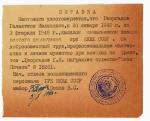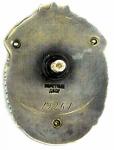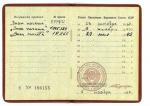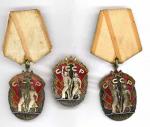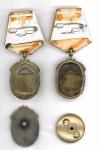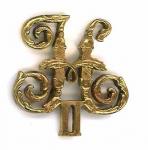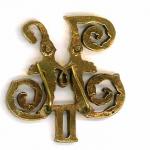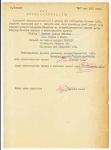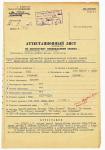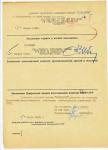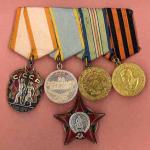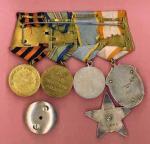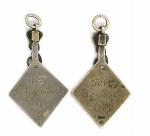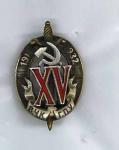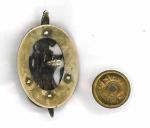-
Posts
1,582 -
Joined
-
Last visited
-
Days Won
1
Content Type
Profiles
Forums
Blogs
Gallery
Events
Store
Everything posted by Chuck In Oregon
-
* * * * * Yes, that's the way I understand it, too. But I have given up trying to explain or understand the vagaries of how Soviet order books were written. I'm happy to let others do that. All I do is show what I have and hope that it starts a discussion. Does anyone have a picture of that train? Chuck
-
... And here's the small NKVD certificate attesting his award of BoH No. 19621, along with a close-up of the reverse of that badge. As best I can translate it, the certificate says the following: Certificate Presented to attest that Georgadze, Galaktian Ivanovich, from 20 January 1942 to 3 February 1946, distinguished himself as chief of the train of the head of and under the auspices of NKVD SSSR. For conscientious work, professional mastery and personal courage, upon leaving the front Comrade Georgadze is awarded the order "Badge of Honor" No. 19261. Chief, Department of Civilian Personnel GUK NKVD SSSR Major Popov, V. S. 5/II 1946 A small but historic documented group. As always, I welcome better, clearer translations than my own. Chuck
-
Galakian Ivanovich Georgadze was the chief of Lavrenty Beria's armored train during the Great Patriotic War. This is his group of three Badges of Honor. I don't remember ever seeing a picture of Beria's train. However, you can still walk through Stalin's personal armored coach at the Stalin museum in Gori.
-

Soviet Order of Glory Medals
Chuck In Oregon replied to a topic in Russia: Soviet Orders, Medals & Decorations
* * * * * Now, THAT'S funny. -

Soviet Comrade Chief Executioner
Chuck In Oregon replied to Chuck In Oregon's topic in Russia: Soviet Orders, Medals & Decorations
As slow on the uptake as ever, I just realized that General Vadis had the same job in 1941 for the 26th Army, then later on various fronts, that Dundua had for Georgia in 1948. That is, assuming that department and section are equivalent translations of the same word. I guess Dundua's timing wasn't quite as good. Special department, indeed. Chuck -

Soviet Comrade Chief Executioner
Chuck In Oregon replied to Chuck In Oregon's topic in Russia: Soviet Orders, Medals & Decorations
* * * * * It wasn't just a factory, it was a steel center. Think Pittsburgh or Gary. Oh yes, they made a lot of steel there. It wouldn't do to disappoint the Man of Steel, don'cha know? However, it was hugely expensive and often of poor quality. Since steel is as much a commodity as anything else, the competition made them ... make lots more and store it! No kidding. It was a boondoggle of enormous proportions. And oh, yeah, Rustavi didn't have any power, either. Still doesn't, for that matter. Chuck -

Soviet Comrade Chief Executioner
Chuck In Oregon replied to Chuck In Oregon's topic in Russia: Soviet Orders, Medals & Decorations
Is that from the NKVD group that came out of the village down near Armenia? If so, you may very well be correct. If I recall correctly -- more and more of a challenge these days -- the main political prison, the one where they carried out the executions, was in Tbilisi. The main super-max for other criminals was in Rustavi. And, of course, there were many other prisons, including some that held German POWs long after the USSR said that the survivors had all been repatriated. May I go off topic? Rustavi is interesting, in a macabre sort of way. It was built on Stalin's whim. What do you do with a big piece of land that has a small town on it but no a) iron, b) coal, c) industry, d) major transportation or shipping facilities, and e) no skilled workers? Why, you build a major steel center and damn the economics! Economics are for capitalists. You can still see the abandoned giant steel mills with their huge smokestacks, reminders of days gone by. Turns out that economics applied to communists, too, but who was going to tell Stalin that? Even a Ukrainian peasant-turned-General-Secretary knew that. The most recent ex-warden of the Rustavi prison is now head of ... are you ready for this? The Georgian National Ballet Company. No, really. I'm not clever enough to make up things like that. Chuck -

Imperial Russia Gold Badge -- 13th Grenadier Regiment
Chuck In Oregon replied to Chuck In Oregon's topic in Russia: Imperial
I knew I'd come across this again one of these days. I was straightening up a bit and I found this misplaced late-period epaulette insignia from the 13th Yerevan Life Grenadier Regiment, Caucasus Grenadier Division, according to my notes. -
I got the origin of these jetons wrong. GeorgeCL was on the right track. This jeton was awarded by the Committee for Strengthening the St. Elizabeth Community of Sisters of Mercy, under the auspices of Princess Eliabeth Fedorovna. It appears that the good sisters, in addition to their acts of mercy, were a fund-raising part of the Imperial Red Cross. I found out from Russian Medical Award Badges that this badge was the first level of recognition for donors to the Imperial Society of the Red Cross. It signified a donation of at least 10 rubles. The donor's name and the year of the donation are on the back. There were other levels of recognition, of course, including a gold version of this jeton for donating an additional 12 rubles and for a donation of no less than 60 rubles the donor was awarded the Badge of the Red Cross. Sorry for the confusion, and thanks to George. Corrections and comments are always welcome. Chuck
-

Soviet Comrade Chief Executioner
Chuck In Oregon replied to Chuck In Oregon's topic in Russia: Soviet Orders, Medals & Decorations
Nice piece of collateral research, RR. I certainly didn't think of doing that. So Vadis retired and Dundua died, both in 1951. Verrry interesting. I'll be interested in whether you find out some more about General Samygin. Thank you, stogieman. I have picked up some unusual things in the last few years and this is one of the most interesting. At least, it is to me. I have a bunch of oddball NKVD (and other) documents. I'll have to start a thread with them one of these days. Translation note: Where I wrote "chief executive" might be better read as, in this context, "chief law enforcement officer". It's not clear to me, but I think the context changes the meaning from simply "executive". -

Soviet Comrade Chief Executioner
Chuck In Oregon replied to Chuck In Oregon's topic in Russia: Soviet Orders, Medals & Decorations
* * * * * I can certainly buy into that likelihood. I doubt we'll ever know, but it's more probable than, say, a traffic accident. I don't think that most of those guys' families got receipts for their personal effects, but to give one in this case might also intentionally further cloud the record. They were devious and deadly rascals. -

Soviet Comrade Chief Executioner
Chuck In Oregon replied to Chuck In Oregon's topic in Russia: Soviet Orders, Medals & Decorations
And how do we know that these are really his awards? This last document is the 1951 receipt from the Georgian MGB for the medals and side-arms of Col. Dundua, turned in upon his death. It is signed both by A. K. Gukasov for the MGB and by E. P. Dundua, the colonel?s widow, who also signed that she received a copy. The sidearms are identified as ?Nagan? revolver s/n VP 2476 and Parabellum pistol s/n 6532. The awards are described as Red Star No. 721391, Badge of Honor No. 88532, Military Service No. 590039 and un-numbered medals for the Defense of the Caucasus and for Victory over Germany. These are the awards in the first picture. So, why does this receipt exist? Why didn?t his family get to keep his modest group of awards? Again according to my friend in Georgia, it was because this existence of this department, as well as the name of its chief, was a state secret and no record of him was to be made available after his death. I do not know the details of his early (age 46) death. It is not quite concurrent with Beria?s bigger purges, but Dundua was likely to have at least been known by Beria. This must have been both a physically and politically hazardous job that didn?t lend itself to a normal retirement. This group languished in MGB/KGB files in Georgia until after independence when they became available by some means. Whether they were given back to the family or stolen when the KGB archives were ransacked or simply lifted by an unpaid employee somewhere along the line, I can?t say. I hope you enjoy this interesting little group. As always, I welcome better translations and interpretations than my own. There you go, Rick. -

Soviet Comrade Chief Executioner
Chuck In Oregon replied to Chuck In Oregon's topic in Russia: Soviet Orders, Medals & Decorations
Here is militia officer Dundua?s 1948 attestation of promotion to Polkovnik, or U.S. full colonel equivalent. Note that they were still thriftily using the old NKGB form! This top secret attestation was issued under the authority of the Okhrana MGB Administration of the Ordjonikidze Railway, by the Deputy Director of the Department of Crime Prevention. It tells us that David Semenovich Dundua was a Georgian born in 1905, he served in the RKKA from 1927-1929 and entered the Cheka in 1930. It goes on to say that he was awarded a Red Star, a Badge of Honor, a Medal for Military Service (aka Combat Service), a Medal for the Defense of the Caucasus and a Medal for Victory over Germany. Those are the ones you see in the first picture. The first endorsement, by Transport General-Major Samigin, states: ?Comrade Dundua D. C. is an old chekist of the transport organ of the NKVD/MGB. In his time working in that organ he gained significant experience as a secret agent and military investigator. In the period of the Great Patriotic War he consistently advanced as an official. Politically mature. Morally stable.? The next endorsement, by Transport General-Lieutenant Vadis, simply agrees to the promotion. Lukewarm, but likely simply a formality. It is in the last paragraph on the back where things get more interesting. It is the actual awarding of the rank and assignment, done by Senior Inspector of the 5th Department UK MGB SSSR, Lt. Col. Maremyanov. He writes: ?Awarded the military rank of Colonel, appointed to the post of chief executive of the special department under the administrative command of the MGB GSSR (Georgian SSR).? So, what was the special department? According to my friends in Georgia, it was the MGB department charged with rounding up and executing political and other criminals. -
Hello O/V Welcome to the forum. You have sure made an impressive start. That is an incredible order. I am not qualified to debate its bona fides. I can only say that it would be the highlight of most advanced collections. Is there a story behind how you found it? I hope that you will keep on sharing with us. Chuck
-
I think that this was a nurse's society, one dedicated to caring for wounded veterans. Does anyone know for sure? These simple jetons are dated 1901 and 1907 with their owner's names, A. G. Verkhovodov and B. S. Esadze, respectively, engraved on the backs. As an aside, names ending with -adze, -idze, -shvili and -shvali are very common in Georgia. All mean "child of". Yes, child and not son or daughter. There are no such distinctions in Georgian. Really. Both jetons are silver with an intricate and distinctive pattern beneath high quality, transparent red enamel. The imperial crowns seem quite different. Does anyone know why? I don't really collect Imperial medical awards and jetons but I have accumulated a number of nice ones. It is an interesting field. When I find the time I'll post an engraved wedding platter from a 1914 military hospital wedding, plus a couple of the newlyweds' badges. Feeling any better now, Rick? Chuck
-

Imperial Russia Post yourImperial russian orders and badges
Chuck In Oregon replied to GeorgeCL's topic in Russia: Imperial
* * * * * OK, stop panting. I've got more to share but I have been way busy lately. The first group I'm going to share will be Soviet, but you'll like it anyway. Maybe on Saturday, if I can clear the time. BTW, my buddy is still negotiating on the attributed gold badge of the first commander of the Caucasus Air Fleet. I plan to go over in the spring and I hope to bring it home with me. With gold at over $560, prices are really getting ridiculous. Chuck -

Imperial Russia Custom Shooting Badge
Chuck In Oregon replied to Chuck In Oregon's topic in Russia: Imperial
* * * * * Yes, I think a white circle inside a blue ring inside a red ring. The same as today, I believe. Chuck -

Imperial Russia Custom Shooting Badge
Chuck In Oregon replied to Chuck In Oregon's topic in Russia: Imperial
That's a knock-out jeton, Pete. Even the box is a great collectible. The color in my badge is a pretty true orange rather than a red. However, I have to allow that the MF might be Maria Feodorovna. (Manny Fernandez? Nah, probably not.) With its gold and silver but lacking proof or maker marks, I have to wonder whether any regimental badges were so unsigned. This is starting to get a lot more interesting than I thought it was! Chuck -

Imperial Russia Custom Shooting Badge
Chuck In Oregon replied to Chuck In Oregon's topic in Russia: Imperial
Hi Rick Thanks, I like the piece too. However, in describing it I would be remiss not to comment on the wavy enamel. I wonder why the original purchaser didn't specify better enamel, as long as he was ordering silver and gold anyway. Chuck -

Soviet "Eggs"
Chuck In Oregon replied to Stogieman's topic in Russia: Soviet Orders, Medals & Decorations
Here's my Cheka 15-Year Jubilee Badge. It is quite a bit different from Rusty's. Four rivets, no number, no proof or maker marks and so forth. I keep thinking that I used to have another Honored NKVD badge than the one you have already seen, but I may have sold it. At the very least, I can't seem to find it at the moment. Chuck -

Imperial Russia Custom Shooting Badge
Chuck In Oregon replied to Chuck In Oregon's topic in Russia: Imperial
* * * * * Yes, it is possible that it is something other than a locally commissioned shooting award. However, that is what I believe it to be. As far as the RAF roundels, good point. But what Luftwaffe pilot would think that they weren't? Chuck -

Imperial Russia Custom Shooting Badge
Chuck In Oregon replied to Chuck In Oregon's topic in Russia: Imperial
WOW! What an outstanding photo. At first I didn't even recognize it as a shooting award because it's so darn big. When I saw the zoom image I couldn't believe it. I haven't seen anything like that before. His tunic has more awards than my whole collection. I hesitate to ask if you would sell it for fear of offending you, but if you would ever consider trading (or selling) that photo I would sure be interested. Can you identify all the other hardware? I am especially curious about that award around his neck. Thanks for sharing that photo. It is a treat to look at it. Would you mind if I saved a copy for myself? Chuck



